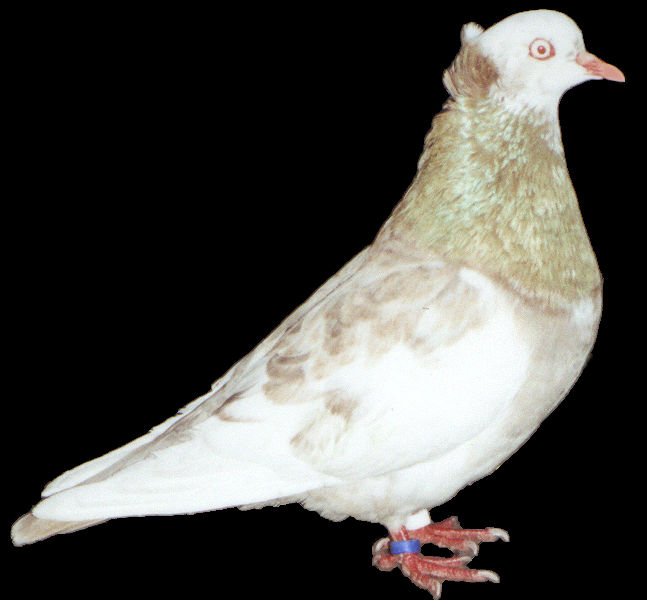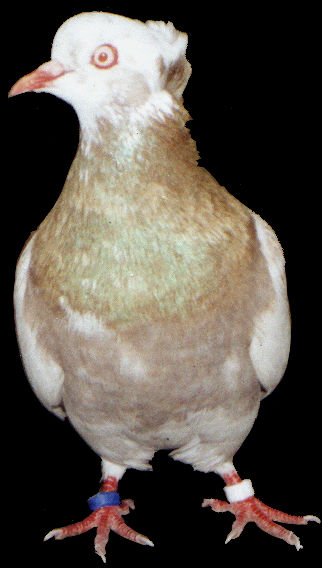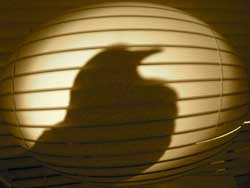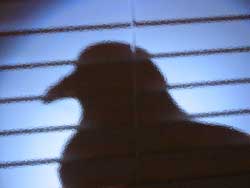New York City Pigeon Rescue CentralPigeon FactsHere you will be able to dispel any errant negative notions you may of had about the venerable Pigeon.
|
Pigeon Facts
Origins
 A trip back in time...
A trip back in time...
The fossil records don’t appear to be that clear when it comes to the rock dove but it’s generally agreed that the bird evolved somewhere in Asia and migrated south to India and North Africa and westwards to as far as the British Isles. These are cliff dwelling birds and that certainly answers the question of why the modern pigeon roosts in the buildings and skyscrapers of the urban areas and generally steer clear of countrysides.
Early man hunted these birds for food but around 4500 B.C., they were being bred and trained for sending messages over large distances. At that time, although it was recognized that the rock dove had a strong homing instinct, it wasn’t known why they exhibited such a behavior. In any event, the birds were bred for a strong homing instinct and when color mutations occurred, they were bred for those desirable colors. All of this served to reduce the number of actual true rock doves and today, there are a only a few original flocks of these birds and some of them inhabit the cliffs of the British coast.
Today’s pigeon is a direct ancestor of the rock dove. Breeding for colors, homing instinct and physical characteristic changes have made origins confusing. Today’s feral, urban pigeon probably contains all or almost all of these changes that were made to it. It’s impossible to point out an original rock dove in NYC because that bird no longer exists in today’s pigeons. The blue and gray bird we see on the city streets today is most representative of the rock dove.
homing instinct and physical characteristic changes have made origins confusing. Today’s feral, urban pigeon probably contains all or almost all of these changes that were made to it. It’s impossible to point out an original rock dove in NYC because that bird no longer exists in today’s pigeons. The blue and gray bird we see on the city streets today is most representative of the rock dove.
Interestingly, all doves share the same family as the rock dove/pigeon. They all produce milk from shedding tissues in the lining of their crops to feed their young. The only other bird that produces such milk is the parrot and that is one reason why it is strongly believed that the pigeon is the ancestor of the parrot families. The young doves/pigeons will insert their beaks into the parent’s throat and drink this crop product until they are about 2 weeks old when at that point, the parents will start to feed small bits of solid food and stop the crop milk feedings. Food will consist of seeds and berries and the very occasional insect needed for additional protein.
It’s difficult to trace the origin of the different species as they evolved and changed. The mourning dove predated man in the New World by 1.8 million years. Whether this bird somehow migrated west as a rock dove or developed here is a mystery. The rock dove never appeared in this area but the passenger pigeon did. The fossil records seem to indicate that the mourning dove was here first but if it evolved into the passenger pigeon or if that bird developed separately isn’t known.
The American Indian hunted the passenger pigeon for food thereby limiting the population growth of the bird. When Western Man migrated to the New World, he brought pox with him and the Indians, never having been exposed to it, were decimated. This allowed the passenger pigeon to multiply dramatically and by the time Audubon, the famous naturalist tried to count the number of pigeons flying overhead, he had to resort to estimations in the millions. These birds were eventually made extinct by the government offering bounties for dead birds. Farmers considered them to be nuisances and it was considered necessary to bring down their numbers. People did not wake up until they didn’t see any passenger pigeons in the skies. It was only then that they realized they had brought the numbers down to only one bird. That bird was housed in the  Cincinnati Zoo until it died in 1914. A reward was offered to anyone who could bring in a live passenger pigeon in order to breed with the captured bird. There were no birds found.
Cincinnati Zoo until it died in 1914. A reward was offered to anyone who could bring in a live passenger pigeon in order to breed with the captured bird. There were no birds found.
Humanity certainly didn’t learn its lesson from the extinction because when the Florida Space Center was built and then Disney World, the encroachment eliminated the living areas of the Orange Breasted Sparrow and that bird disappeared save one that was kept in the Disney Zoo in the hope that another one would be found. Another one never was found.
It’s known that the Spanish brought pigeons over here for food. Many of these birds escaped and became the urban pigeon we see now. The pigeon knows two things; there are “Cliffs where people live and where there are people, there is food. Today’s pigeon is considered “Dirty” by a lot of people. Nobody ever stopped to realize that our cities were not constructed with a thought for the wildlife living within its borders. If it’s true (it isn’t) that the bird is dirty, it’s because they have been made to live in a city made dirty by people.
Fred 128
Back to topTV series segment, Healthier Living, shows how feeding pigeons helps relieve the stresses of day to day living.
Is The Pigeon Dangerous To People?
The REAL FACTS about pigeons and public health:
Dr. Michael McNeil, Centers for Disease Control (CDC) in Atlanta.
"Diseases associated with [Pigeons] present little risk to people..."
"One man's nuisance is another man's pleasure."
Guy Hodge, Naturalist for the Humane Society of the United States.
"'People worry that pigeons carry disease,' but the danger is 'an exaggeration created by pest control companies looking for business.'" -
"[...the Arizona Department of Health Services does] not have any documented human cases of disease which have been definitively linked to outdoor pigeons or pigeon droppings. When cases of diseases are reported
(and by law [certain bird related zoonoses are] reportable diseases), VBZD staff conduct complete investigations to confirm the diagnosis and identify the source of infection...
Our case investigation data gathered so far, would suggest that pigeons are not significant as a cause of human disease in Arizona."
Dr. Marshall Lyon, National Center for Infectious Diseases, Centers for Disease Control and Prevention (CDC) in Atlanta
“We do have some concern about the indiscriminate killing of pigeons.” “[For example, histoplasmosis disease rates are] misleading and irrelevant, because histo’s so ubiquitous. It’s in the soil, regardless of whether pigeons are around or not."
Dr. Manuel Vargas, New York City Department of Health.
 "The New York City Department of Health has no documented cases of communicable disease transmitted from pigeons to humans."
"The New York City Department of Health has no documented cases of communicable disease transmitted from pigeons to humans."
Dr. Alex Bermudez, University of Missouri-Columbia College of Veterinary Medicine
"Problematic density [affecting human safety] is probably more determined by people getting their possessions defaced.” “I’m not terribly worried about pigeons.”
Bill Kottkamp, Supervisor, Vector Control, St. Louis County Health Department
“We don’t see pigeon-related-disease problems...” “I don’t think they’re seeing them anywhere..." -
Larry Webert, R.S., Mohave County Environmental Health Division
"I am not aware of any reported cases of diseases that were transmitted by pigeons in Mohave County."
Arizona
Animals@urbanwildlifesociety.org
Back to topPigeons Conceptualize?
Implications for Humanity
Psychologists at Harvard (Herrnstein and Loveland, 1964), have established that laboratory pigeons can use concepts in ways that have been considered uniquely human. Employing Skinnerian techniques to assess the pigeons' ability to discriminate between different photographic slides projected on a screen, the researchers found that pigeons include under the concept of "human" both male and female humans of every race, culture, color, chronological age, and size. The pigeons also identify the back of a human head, a human hand or foot, and other parts of the human anatomy as "human," and they recognize a particular human under various "disguises" such as when the person is nude, or wears strange clothes, or is a tiny face in a large group photograph. Even more surprising, the pigeons had the concept of "man-made objects" (such as streets and buildings), "natural objects" (such as forests and fields), and they even distinguished esoteric objects, such as equilateral triangles from other kinds of triangles.
Also, psychologists at Brown University (Blough, 1982) demonstrated that laboratory pigeons can learn to recognize each of the 26 letters of the English alphabet. Initially, the birds made the same kinds of mistakes as elementary school children--confusing C and G, and W and V.
Implications for Humanity
The implications are tremendous. If, as the evidence indicates, animals are aware, and birds have human-like intelligence, emotions, and personalities, then... modern humans have been fundamentally wrong about the nature of basic reality. Since they have been mistaken about their closest and most common wild neighbors, the birds, they need to reassess and reevaluate their presumed understanding of reality and their relationship to everything around them, beginning with birds and extending out to all animals and all of nature.
As the willfulness and awareness of birds and other animals penetrate to the consciousness of forthcoming generations, modern human cultural institutions, including science, philosophy, and religion, will change drastically. No longer will official science attribute intelligence only to humans; on the contrary, the next generation of scientists will be increasingly cognizant of the mindfulness and purposefulness of other living beings. No longer will philosophers philosophize with total disregard to the planet's non-human animals, no longer will religions focus only on God and people while ignoring all other creatures. As people realize the true extent of awareness in animals, a new respect and reverence will enter into their relationships with the rest of the natural world.